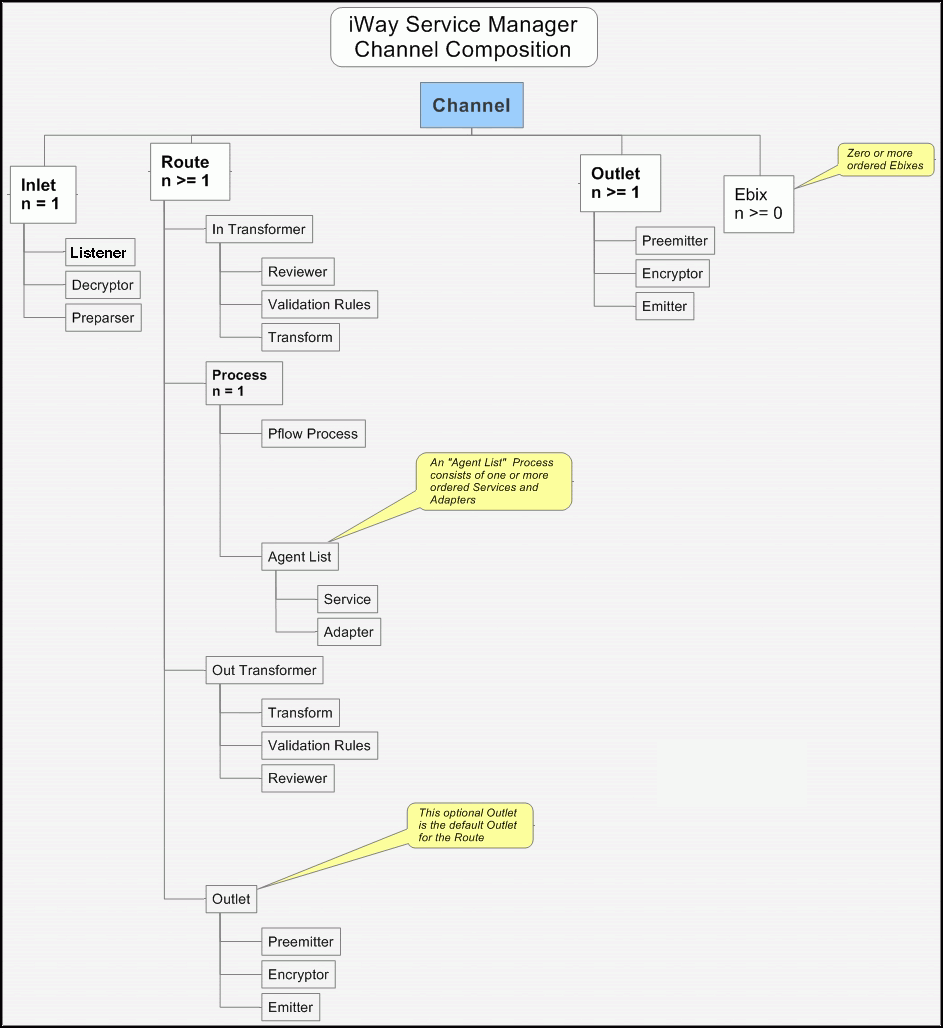Using a Channel to Construct a Message Flow
|
Topics: |
The use of iWay Service Manager is centered on a channel. A channel is a container for all the iWay business components used in an SWIFT message flow.
At a high level, a channel accepts input data via an inlet, processes the data via a route, and outputs the resulting data via an outlet. Another component in the process is an e-Business Information Exchange (Ebix).
The following diagram shows the channel components available in the construction of a message flow.
In the following diagram, the value n underneath a component name indicates how many instances of that component you can have in a channel configuration—zero, one, or more than one. For example, n = 1 for Inlet means that you can have only one inlet on the channel.
Required components are in boldface type.

Components of a Channel
A channel consists of:
- An inlet, which defines how a message enters a channel.
- A route, which defines the path a message takes through a channel.
- Outlets, which define how transformed messages leave a channel.
- An e-Business Information Exchange (Ebix), which is a collection of metadata that defines the structure of data.
iWay Service Manager provides a design-time repository called the Registry, where you assemble and manage the components in a channel.
An inlet can contain:
- A listener (required), which is a protocol handler responsible for picking up an incoming message on a channel.
- A decryptor, which applies a decryption algorithm to an incoming message and verifies the security of the message.
- A preparser, which is a logical process that converts an incoming message into a processable document. The preparsed document then passes through the standard transformation services to reach the designated processing service.
A route can contain:
- An in transformer,
which is an exit sequence that is applied to a message before processing
occurs.
- A reviewer, which is either the first exit to receive a document after parsing (inbound), or the last exit to receive a document prior to the actual emit operation (outbound). These exits are intended for envelope handling but can be used for any desired purpose.
- Validation rules, which apply validation using the rules validation engine. Rules are provided when the iWay Integration Solution for SWIFT is installed.
- A transform, which is a transformation definition file that contains sets of rules, interpreted and executed by a transformation engine. Transformation is the process by which data is transformed from one structure/format to another.
- A process,
which is a stateless, lightweight, short-lived microflow that is
executed by iWay Service Manager on a message as it passes through
the system. Processes that are published using iIT Designer are
available in the Registry and can be bound to channels as routes.
- A process flow.
- An agent list.
- A service, which is an executable Java procedure that handles the business logic of a message.
- An adapter, which refers to a target that represents a specific instance of a connection to a back-end system.
- An out transformer,
which is an exit sequence that is applied to a message after processing
occurs.
- A transform, which is a transformation definition file that contains sets of rules, interpreted and executed by a transformation engine. Transformation is the process by which data is transformed from one structure/format to another.
- Validation rules, which apply validation using the rules validation engine. Rules are provided when the iWay Integration Solution for SWIFT is installed.
- A reviewer, which is either the first exit to receive a document after parsing (inbound), or the last exit to receive a document prior to the actual emit operation (outbound). These exits are intended for envelope handling but can be used for any desired purpose.
- An outlet
(optional), which is responsible for all aspects of preparing a document
for emission and then emitting it.
- A preemitter, which is a logical process that handles a document immediately before transmission. Normally it converts an XML document into non-XML format.
- An encryptor, which can be called to encrypt an outgoing document.
- An emitter, which is a transport protocol that sends a document to its recipient.
An outlet can contain:
- A preemitter.
- An encryptor.
- Multiple emitters.
For details on the preceding components, see the iWay Service Manager User's Guide.